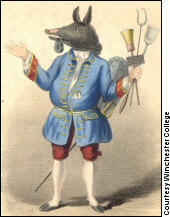Hircocervus
When one reads Umberto Eco one must be prepared for exotic words. This one appears in the English translation by William Weaver of Eco’s The Island of the Day Before:
Perhaps he would have done the same if he had taken up creating scenes for the theater: do not playwrights derive improbable and clever events from passages of probable but insipid things, so that they may be satisfied with unexpected hircocervi of action?

The Hircocervus or
Trusty Servant
A hercocervus is a fabulous beast, half goat, half stag. The idea of the goat-stag goes back at least to Plato, who used it as an example of a thing that was knowable even though it didn’t exist. Its first appearance in English is in a manuscript of 1398 now in the Bodleian Library in Oxford. In origin it is just the Latin word for a billy goat (hircus) attached to that for a stag (cervus). (The more usual Latin for a male goat is caper and for a female capra, as in the astrological sign Capricorn; hircus appears only in some rare words such as hircose, goat-like, and in the formal scientific name for the common goat, Capra hircus.)
The fabulous animal has not, however, always had a simple form of a goat and a stag. In a book by Arthur Cleveland Coxe, Impressions of England, published in 1856, he wrote about a famous painting at Winchester College:
I must not omit to mention the time-honoured Hircocervus, or picture of the ‘trusty servant,’ which hangs near the kitchen, and which emblematically sets forth those virtues in domestics, of which we Americans know nothing. It is a figure, part man, part porker, part deer, and part donkey; with a padlock on his mouth, and various other symbols in his hands and about his person, the whole signifying a most valuable character.
The views of the college menials on this characterisation are not recorded.

